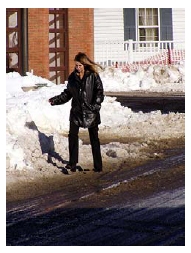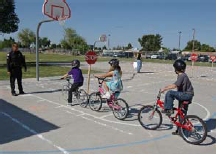U.S. Department of Transportation
Federal Highway Administration
1200 New Jersey Avenue, SE
Washington, DC 20590
202-366-4000


U.S. Department of Transportation
Federal Highway Administration
View the PDF Version [289 KB]
In this issue:
Accessibility Resources: Public Right of Way Guidelines
FHWA Awards Contracts to Develop and Revise Materials
New and Ongoing Pedestrian and Bike Program Activities/Products from NHTSA
Transportation Enhancements and Recreational Trails Program Updates
Contributed by Christopher Douwes
The US Access Board announced its Notice of Proposed Rulemaking (NPRM) on Accessibility Guidelines for Public Rights-of-Way on July 26, 2011. The guidelines are posted on the Board's website and will be available for public comment through November 23, 2011. The Board will conduct several events to present the proposed rule and to solicit comments, including a public briefing and press conference, a webinar, and hearings. See www.access-board.gov/prowac/.
The guidelines cover pedestrian features in new or altered public rights-of-way, including sidewalks and other pedestrian ways, street crossings, medians and traffic islands, overpasses, underpasses and bridges. Onstreet parking, transit stops, toilet facilities, signs, and street furniture are also addressed. The guidelines apply to permanent as well as temporary facilities, such as temporary routes around work zones and portable toilets.
Pedestrian safety is an important consideration in the Access Board’s guidelines. Wheelchair users usually have a lower eye height above the street than most adult pedestrians, and may be hidden from motorist view behind parked vehicles, plantings, or other visual obstacles. People may have vision, hearing, cognitive, or other considerations that must be considered within the public right-of-way.
Provisions in the guidelines address:
The US Access Board announced an Advance NPRM for Shared Use Paths on March 28, 2011, see www.access-board.gov/sup/anprm.htm. Although comments were due June 27, 2011, these guidelines are in initial development stages. The proposed guidelines will consider differences between public right-of-way guidelines and recreational trail guidelines.
The US Access Board expects to announce a final version of Accessibility Guidelines for Outdoor Developed Areas in early 2012, see www.access-board.gov/outdoor/. These include guidelines for recreational trails, outdoor recreation access routes, beach access routes, and picnic and camping facilities. Although these guidelines are intended for Federal agencies and direct Federal projects, they will be the state-of-the-practice for recreational trails. The Federal Highway Administration (FHWA) will recommend use of these guidelines for recreational trails that have Federal Aid funds.
The USDA Forest Service released an Accessibility and Recreation Projects DVD. See www.fhwa.dot.gov/environment/rectrails/trailpub.htm to order. This DVD is a collection of the most-requested reports and tech tips on accessibility and recreation published by the Missoula and San Dimas Technology and Development Centers.

The FHWA Safety Office recently awarded a contract to revise several pedestrian and bicycle safety materials developed in the past decade based on feedback collected as part of another project. The materials (Pedsafe: Pedestrian Safety Countermeasure Selection System; Safer Journey; Bikesafe: Bicycle Countermeasure Selection System; Safer Bicycle Journey; and The Residents Guide for Creating Safe and Walkable Communities) will be revised over the next three years in the order they are listed above.
FHWA also awarded a contract to develop a Guide for Maintaining Pedestrian Facilities for Enhanced Safety with two objectives:
The guide would identify best practices and barriers for sidewalk/ shared use path maintenance: what works and what does not work based on experience from State and local agencies. The guide would provide examples and experiences from jurisdictions that have developed effective policies for selecting and maintaining pedestrian facilities in terms of responsibilities, enforcement, allocation of costs, and related issues. The research and guide will be completed in 2 years.
Contributed by Paula Bawer
The National Highway Traffic Safety Administration (NHTSA) is working to adapt its existing materials to be more suitable for middle to high school-aged youth (the language will only be slightly different from existing materials but should reference YOUTH versus KIDS and have pictures of older children). If you have pictures you would like NHTSA to consider using in these materials and have parents' permission for use, please e-mail: paula.bawer@dot.gov

Bicycle Safety Education for Children from a Developmental and Learning Perspective. The project will provide a review of the literature and a much needed research-based reference for developing approaches for bicycle safety education and children. This will be a companion to the existing pedestrian safety education piece completed by NHTSA (see: www.nhtsa.gov/DOT/NHTSA/Traffic%20Injury%20Control/Articles/Associated%20Files/811190.pdf). Expected completion is early spring 2012.
Demonstration: Walk and Bike Safely: For Adult Literacy English Language Learners. Based on the similar product for Adult English Language Learners (beginning level), this project will test the product's usefulness for volunteer instructors with adult students in faith-based and community settings. The focus will be to reach Hispanic immigrant adults and, through them, reach their families and children.
Responsible Walking and Bicycling: for Middle School-aged Youth. This curriculum will focus exclusively on knowledge and understanding of walking and bicycling as transportation options and introduce safety principles needed as the foundation for safe driving. The lessons will include traffic signs and signals, communicating with traffic and why pedestrians, bicyclists, and motorists do what they do to be safe. Support materials will include handouts and games/activities suited to for middle schoolers. While intended for use in this product, some materials will be designed as standalone pieces that can be used for varying purposes. Pilot testing is expected to be done this winter, 2011-2012. Project Completion: Late spring 2012.
(In Spanish—Video) Keep Looking. Pedestrian Safety Video for Older Children (Grades 3-5) – Expected completion spring 2013)
(Handout) Prevent Pedestrian Crashes: For Youth. This downloadable handout based on the current preschool & elementary school version will be revised for older children. It will be part of the walk/bike middle school-aged youth curriculum. Expected late fall 2012
(Handout) Safe Walking: Tips for Youth (Y) – This downloadable handout will be based on the current Kids Guide to Safe Walking and will be updated for middle school children. It will be part of the walk/bike middle school youth curriculum. Expected fall 2012.
(Handout) Safe Bicycling: Tips for Youth. (Y) – This downloadable handout will be based on the current Kids and Bicycle Safety and updated for older children. It will be a standalone and part of the walking/biking middle school-aged curriculum. Expected fall 2012.
(Handout/Activity) Walk Friendly Community Assessment (Y) – This will be based on the current Walkability Checklist and revised for middle-school children. It will be part of the walk/bike middle school-aged youth curriculum. Expected spring 2012.

(Handout/Activity) Bike Friendly Community Assessment. (Y) This will be revised for older children based on the current Bikeability Checklist. It will be part of the walk/bike new curriculum for middle school-aged youth. Expected spring 2012.
Pedestrian & Bicycle Safety Curriculum for Adult English Language Learners. This includes two products designed for adult (18 and over) immigrants learning English: (1) a pedestrian and bicycle safety curriculum for beginning level adult English language learners. Mainly pictures and verbal discussions will be used to communicate basic safety messages rather than written information, and (2) an intermediate version. Both products include an instructor guide, two audio clips, and a student workbook and can be found on the NHTSA website: http://www.nhtsa.gov/Driving+Safety/Pedestrians/For+English+as+Second+Language+(ESL)+Teachers+and+Learners.
Pedestrian Safety Curriculum for Children. Curriculum for children grades K-5. The course materials include supplemental take-home activities for parent/guardian involvement in the learning process and parent tip sheets (S) (P). Use materials in safe routes to school (SRTS) programs and/ or adapt and personalize for local use. www.nhtsa.gov/ChildPedestrianSafetyCurriculum. Consider use with Willie Whistle video below.
(Video) Stop and Listen – Willie Whistle – Pedestrian Safety Video for Children (ages K-2). (Completed) (S) (P) This ~ 7 minute DVD covers safe street crossing, see: www.nhtsa.gov/people/injury/willie/video.html.
NHTSA continues to add new materials for pedestrian and bicycle safety for kids to its website and staff are happy to identify resources for you. Note that only the videos are available in hard copy, everything else is downloadable via the website: www.nhtsa/pedestrians/ or www.nhtsa/bicycles/
For information on bicycle safety and SRTS contact: paula.bawer@dot.gov
For information on pedestrian safety/pupil transportation contact: leah.walton@dot.gov
Contributed by Christopher Douwes
The National Transportation Enhancements Clearinghouse (NTEC), operated by the Rails-to-Trails Conservancy, issued the Transportation Enhancements Spending Report for FY 2010. This report analyzes how States use Transportation Enhancement (TE) funds.
See: Publications page
Executive Summary (PDF 173 KB)
Full Report (PDF 6.6 MB)
TE funds are the single largest source of funding for pedestrian facilities in the United States, and TE funds also may be used for pedestrian and bicyclist safety education. See www.fhwa.dot.gov/environment/te/ for more information.
The Transportation Enhancements Professional Seminar took place on August 29-30, 2011, in San Francisco, CA. Presentations and other seminar information is available at www.enhancements.org/seminar/SF_proceedings.asp.
The State Trail Administrator's Training Meeting took place September 14-15, 2011, in Grand Rapids, MI. Meeting information is posted at www.fhwa.dot.gov/environment/rectrails/stam2011/, and presentations will be posted in October and November 2011. Recreational facilities also must consider pedestrian safety and accessibility. See program information at www.fhwa.dot.gov/environment/rectrails/.
The Recreational Trails Program and TE Program Update is posted at www.fhwa.dot.gov/environment/rectrails/news/

Tamara Redmon, Pedestrian Safety Program Manager This Pedestrian Forum is available on the Web at http://safety.fhwa.dot.gov/ped_bike/pedforum/ To receive information on future newsletters, please use the e-subscription service provided on this site: http://safety.fhwa.dot.gov/esubscribe.cfm#ped. Scroll down to "Pedestrian and Bicycle Safety" and select "subscribe" next to "Pedestrian Forum." |
Livable communities are a high priority of the U.S. Department of Transportation and the Obama Administration. A livable community is one that provides safe and convenient transportation choices to all citizens, whether it's by walking, bicycling, transit, or driving. Each year, unfortunately, pedestrian fatalities compose about 12 percent of all traffic fatalities, and there are approximately 4,000 pedestrian deaths. Another 70,000 pedestrians are injured in roadway crashes annually. The numbers are improving, but we still have a ways to go. Pedestrian safety improvements depend on an integrated approach that involves the four E's: Engineering, Enforcement, Education, and Emergency Services. The Pedestrian Forum highlights recent pedestrian safety activities related to the four E's that will help save lives. |

